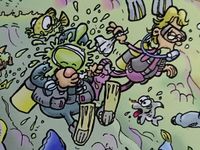Equalization
Pressure equalization is necessary to balance the pressure difference between air-filled body cavities and the environment. In diving, pressure equalization is generally understood as equalization of the pressure in the middle ear and the sinuses to the ambient pressure in the respective depth.
Before your first dive
For sure, you have feeled already in the airplane or during diving in a pool a pressure on your ears. During scuba diving you will also feel this pressure. Therefore it is mandatory to equalize during descent immediatly when you feel a slight pressure in your ears. Pinch your nose with your thumb and forefinger and try to exhale gently through the now closed nose. You should hear some sound and the pressure-feeling should immediatly release.
- Warning
If you cannot equalize, do not descend any further, let your VIT instructor know immediately with the underwater hand signal shown below. He will react accordingly.
Basic knowledge for Open Water Diver* (OWD*)

The tympanic cavity, the area behind the eardrum in the middle ear, is an air-filled space. It is sealed through the eardrum towards the outer ear. If the ambient pressure changes when the diver is de- or ascending on a dive, a relative pressure difference arises in the tympanic cavity. This will deform the eardrum. With only little difference in pressure, you feel this as pressure your ears. As the pressure difference increases, the deformation of the eardrum becomes larger and you feel strong, stabbing pains. To avoid damage or even tearing of the eardrum, the pressure difference must be compensated by a pressure equalization.
On descend, before you feel any pain you pinch your nose with your thumb and forefinger and try to exhale gently through the now closed nose (so-called active pressure equalization). This builds up a pressure in your nasopharynx, which opens the Eustachian tubes to your tympanic cavity. Since you are breathing compressed air from your regulator which accounts for the current ambient pressure, this compensates for the pressure difference between the middle and outer ear and the eardrum falls back to its normal position. When ascending, the Eustachian tubes are opened by the overpressure in the middle ear (so-called passive pressure equalization).
The pressure equalization must be carried out frequently during descent. It is best if you only feel slight pressure on your ears. If you are already in pain, you might not be able to equalize due to the Eustachian tubes being pressed close by the ambient pressure. Never force the pressure equalization by forceful pressing. If the pressure equalization does not work, never dive deeper, reduce the depth or stop the dive, otherwise you will risk a rapture of your eardrums. If necessary, you should visit an ENT specialist.
Most common causes why you can't equalize:
- You forgot to equalize and the Eustachian tubes are already pressed close.
- You have a cold, the mucous membranes especially in the Eustachian tubes are swollen and cannot or can only inadequately open.
- An ear plug or a plug of earwax block the ear cannel.
- A to tight hood prevents pressure equalization.
Some tips to avoid aborting a dive because of not working pressure equalization:
- Try equalizing before diving on the water surface.
- Perform pressure equalization already if you feel a slight pressure on the ears.
- Never dive with a cold or an infection.
- Do not use decongestants. The effect diminishes to the end of the dive and the passive pressure equalization on ascend is no longer possible.
- Avoid whatever increases mucus production in the body (e. g. smoking).
- Do not use earplugs or cotton swabs to clean ears.
- Lift a tight-fitting hood slightly during equalization.
- Descend as slowly as possible with various stops.
- Avoid yo-yo dives in shallow water.



